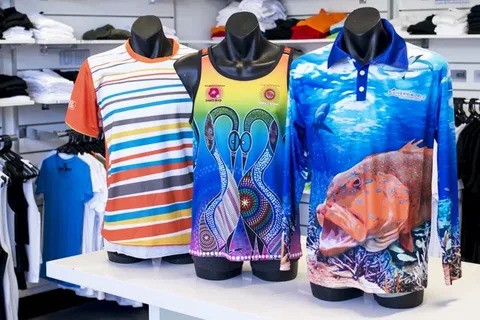Sublimation Printing on Apparel: The Best Printing Method for Vibrant, Lasting Results

In the world of custom apparel, few printing methods offer the vivid color, durability, and versatility that sublimation printing does. As fashion trends shift toward personalized designs and print-on-demand models, sublimation has become the go-to method for businesses, designers, and individuals seeking high-quality results on fabric. Whether for sportswear, uniforms, branded t-shirts, or fashion-forward designs, sublimation printing on apparel delivers professional results that stand out.
In this article, we’ll explore what sublimation printing near me is, why it’s ideal for apparel, how it compares to other printing methods, and the key benefits it offers.
What is Sublimation Printing?
Sublimation printing is a heat-transfer process that turns solid dye into gas without passing through a liquid state. The design is first printed onto special sublimation paper using sublimation ink. Then, using a heat press, the paper is pressed against the fabric at high temperatures (usually around 380–400°F). This causes the dye to vaporize and bond with the polyester fibers of the garment on a molecular level.
The result? A vibrant, full-color print that becomes part of the fabric itself—not just sitting on top of it like with other methods.
Why Sublimation is the Best Printing Method for Apparel
Sublimation stands out for several key reasons that make it the preferred method for custom clothing:
1. Vibrant, Full-Color Prints
One of the most celebrated advantages of sublimation is its ability to produce photo-realistic, full-color designs. Unlike screen printing or vinyl, which may require layers or limited colors, sublimation can effortlessly replicate gradients, shadows, and high-resolution images.
2. Long-Lasting and Durable
Because the ink becomes part of the fabric rather than sitting on top, sublimated prints won’t crack, peel, or fade over time. Even after numerous washes, the colors stay as vivid as the first day. This makes it ideal for activewear, uniforms, and frequently worn apparel.
3. Soft to the Touch
Unlike plastisol-based screen prints or vinyl transfers, sublimated designs are completely smooth and breathable. The ink doesn’t add any extra texture to the shirt, maintaining the fabric’s natural feel and flexibility—especially important for sports and fitness apparel.
4. All-Over Printing Capabilities
Sublimation allows for edge-to-edge printing, covering the entire garment with a design. This opens up creative possibilities for full-coverage patterns, graphics, or branding elements—something not possible with most other printing methods.
Best Fabrics for Sublimation
Sublimation works best on polyester fabrics or polyester blends. The dye bonds specifically with polyester molecules, making natural fibers like cotton less effective unless treated with a polymer coating.
Ideal garments for sublimation include:
- 100% polyester t-shirts
- Performance sportswear
- Polyester hoodies
- Polyester tote bags and accessories
- Jerseys and uniforms
For those who still want the comfort of cotton but the look of sublimation, cotton-poly blends (with at least 65% polyester) offer a workable compromise, though the results won’t be as vibrant.
Sublimation vs. Other Printing Methods
Let’s compare sublimation to other popular apparel printing techniques:
| Method | Durability | Color Range | Feel | Best For |
|---|---|---|---|---|
| Sublimation | Excellent | Full-color/photo | Soft, no feel | Polyester garments, sportswear |
| Screen Printing | Very Good | Limited per layer | Slightly raised ink | Cotton tees, bulk orders |
| DTG Printing | Good | Full-color | Soft on cotton | Short-run, high-detail cotton garments |
| Heat Transfer | Moderate | Full-color | Slightly stiff feel | Promotional wear, small batches |
As the chart shows, sublimation excels in color vibrancy, longevity, and softness—making it one of the best options for high-quality, customized polyester apparel.
When to Use Sublimation Printing
Sublimation is particularly well-suited for:
- Sports Teams: Full-color uniforms and activewear that withstand sweat and washing.
- Fitness Apparel Brands: Lightweight, breathable prints for performance wear.
- Corporate Branding: Company shirts with bold logos and messaging.
- Fashion Designers: Unique patterns and designs covering the entire garment.
- Event Merchandise: Durable and eye-catching apparel for concerts, festivals, or fundraisers.
Limitations of Sublimation Printing
While sublimation is an incredible method, it’s not perfect for every situation. Consider these limitations:
- Fabric Restriction: Works only on polyester or polymer-coated materials.
- Light-Colored Garments Only: Sublimation doesn’t print white ink, so it’s best on white or light-colored garments.
- Initial Setup Cost: Requires special printers and inks, which may be expensive for beginners.
Still, for those targeting vibrant, long-lasting designs on polyester apparel, sublimation is a top-tier choice.
Conclusion
Sublimation printing on apparel has quickly risen to the top of the industry for good reason. It offers unmatched color brilliance, long-lasting prints, and a lightweight, breathable finish that other methods struggle to achieve. Ideal for athletic gear, fashion brands, and on-demand businesses, sublimation brings designs to life in stunning detail.
Whether you’re launching a clothing line, printing uniforms, or designing custom gifts, sublimation printing provides the quality, durability, and style your project deserves.

